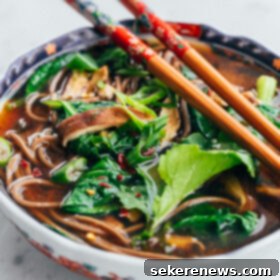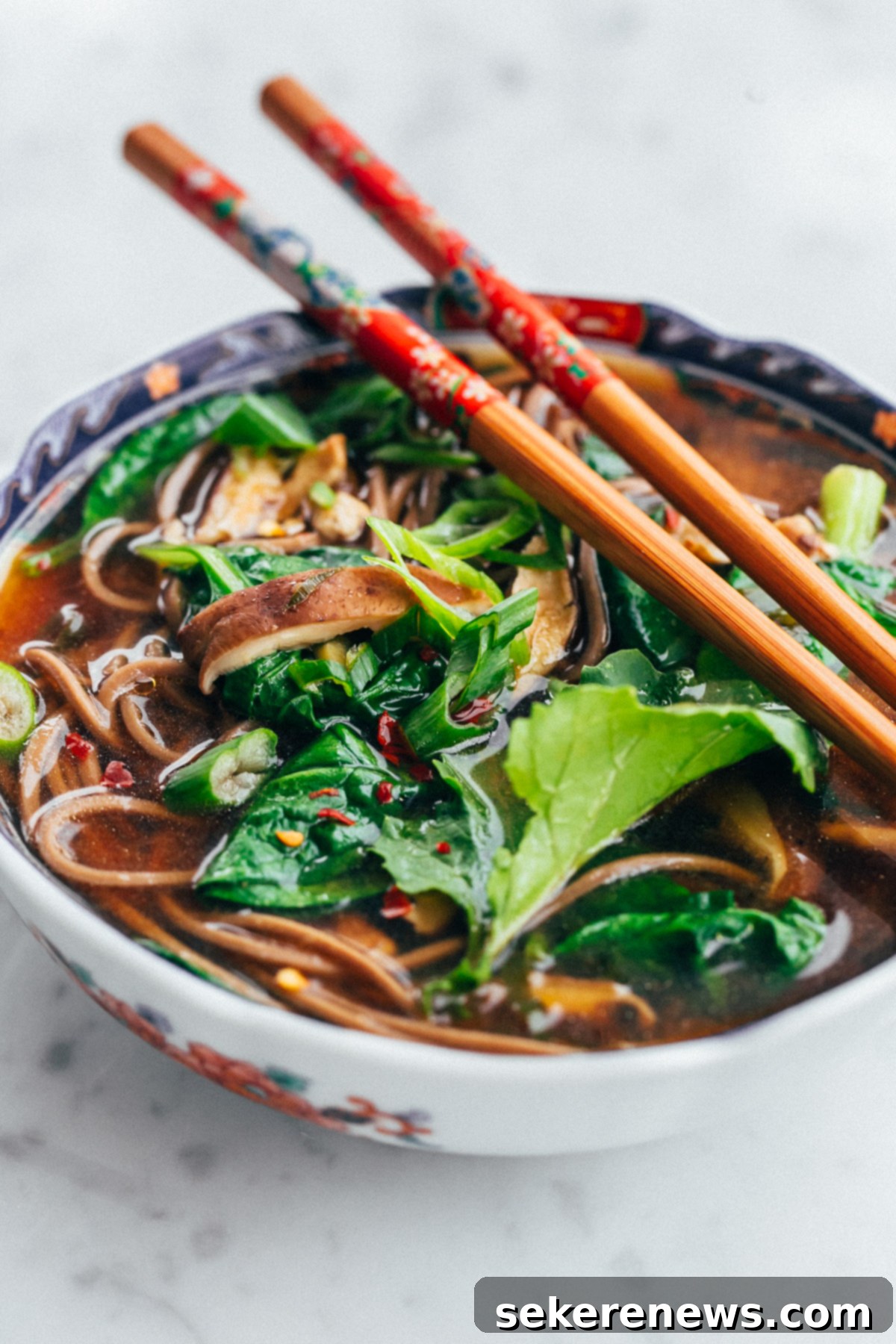Mastering Vegan Miso Soup: A Delicious Shiitake and Spinach Recipe from The Love & Lemons Cookbook
Delicate and flavorful Shiitake and Spinach Miso Soup, inspired by the beautiful and insightful The Love & Lemons Cookbook. This recipe embodies the simplicity and seasonal elegance that defines Jeanine Donofrio’s approach to plant-forward cooking.

For many food enthusiasts and home cooks, this particular season holds a special kind of magic. While spring brings its own refreshing charm (despite unexpected snow flurries in Chicago, as my weekend grocery run with Connor humorously reminded me!), it’s the annual “cookbook season” that truly captures my culinary heart. It’s a time when many talented friends and respected figures in the online food community release their latest masterpieces – beautiful, inspiring, and often breathtakingly stunning cookbooks that promise fresh ideas and delicious adventures in the kitchen. Just last week, I had the pleasure of sharing a fantastic recipe from Andie Mitchell’s much-anticipated Eating in the Middle.
This week, the spotlight shines on another culinary gem: a wonderfully simple yet elegant recipe from The Love and Lemons Cookbook, authored by the incredibly talented duo, Jeanine Donofrio and Jack Mathews. As a long-time admirer and reader of their blog, I’ve eagerly awaited the release of this book since its announcement years ago. The excitement of finally holding a copy and diving into its pages is truly immense, and I am absolutely thrilled to share a glimpse into their world of vibrant, plant-based cooking with you today.

The Philosophy Behind Love & Lemons: Celebrating Seasonal, Plant-Forward Cooking
What I’ve consistently loved, related to, and admired about Jeanine and Jack’s approach to cooking is its inherent simplicity and profound respect for ingredients. Their philosophy is beautifully straightforward: begin with the highest quality, local, and seasonal ingredients you can find, and let them guide your culinary creations. This fundamental principle genuinely transforms a dish, elevating everyday meals into something truly extraordinary. It’s an ingredient-driven philosophy that prioritizes freshness, flavor, and the natural bounty of each season.
The Love and Lemons Cookbook is masterfully structured around this very logic, which is one of its most appealing features. As its title cleverly hints, the book is an exuberant “apple-to-zucchini” celebration of spontaneous and inventive cooking. While every recipe in the book is inherently vegetarian, Jeanine thoughtfully includes tips for making each dish gluten-free and vegan, showcasing a remarkable versatility. Although I don’t exclusively follow a vegetarian diet, I consistently find myself drawn to cooking a multitude of plant-based meals. There’s a distinct joy and lightness in preparing food this way that I deeply appreciate. Regardless of your dietary preferences, this cookbook is an indispensable resource that truly deserves a cherished spot in every kitchen, inspiring healthier and more flavorful cooking.

Cooking Backward: Embracing Intuition and Farmer’s Market Finds
One of the most innovative aspects of The Love & Lemons Cookbook is its unique organization. Instead of traditional chapters based on meal types (like breakfast, lunch, or dinner), the book is thoughtfully arranged by vegetable. Imagine finding chapters dedicated to nearly every vegetable imaginable: artichokes, various cabbages and chicories, crisp cucumber, aromatic herbs, vibrant peppers, hearty root vegetables, and comforting winter squash. This ingenious concept is incredibly empowering for home cooks.
It allows you to glean inspiration directly from the ingredients you already have on hand. For instance, if you discover a forgotten head of cauliflower in your refrigerator, you simply turn to the cauliflower chapter for a wealth of creative recipe ideas. Alternatively, you can reverse your cooking process: purchase a beautiful, seasonal ingredient that catches your eye and then work backward to decide what to make. This approach is particularly valuable and enjoyable if you frequent farmer’s markets, where the freshest, most compelling produce often dictates your meal plan. Jeanine and Jack excel at providing abundant tips and practical guides for this kind of impromptu, intuitive cooking throughout their book, making it accessible and fun for everyone.


Beyond Recipes: The Aesthetics of Culinary Inspiration
And speaking of the book itself, it’s imperative to mention its sheer aesthetic brilliance. From the exquisite photography that makes every dish leap off the page, to the thoughtful design and elegant typography, every element of The Love & Lemons Cookbook is a testament to quality and passion. It’s more than just a collection of recipes; it’s a piece of art that invites you to engage with food on a deeper, more visually satisfying level.
One of my personal goals for the year is to shift more of our everyday grocery shopping towards local farmer’s markets here in Chicago. The benefits are manifold: not only do I love supporting dedicated local farmers and their sustainable practices, but I also gain an immense amount of recipe inspiration and a sense of connection to the food I eat. While food blogging, with its demands for consistent ingredient access and repetitive testing, can sometimes make this spontaneous approach challenging, the rewards of farmer’s market shopping are undeniable.

For anyone aspiring to become a more intuitive cook – a journey I highly recommend, perhaps even with the help of these insightful books – farmer’s markets serve as an ideal starting point. The very nature of these markets gently compels you to adapt and experiment. As any seasoned farmer’s market enthusiast knows, rigid, hyper-focused shopping lists often clash with the vibrant, ever-changing bounty on display. The last thing you want to do is become so fixated on finding a specific item that you overlook the truly incredible, peak-season fresh basil or the perfect summer squash beckoning from a neighboring stall. It’s about letting the ingredients inspire you, rather than being confined by a predetermined plan.

The Star Dish: Shiitake and Spinach Miso Soup
Today’s featured recipe, the Shiitake and Spinach Miso Soup, perfectly exemplifies this concept of “cooking backward.” In a delightful stroke of serendipity, I found myself with an abundance of fresh shiitake mushrooms in my refrigerator – a truly aligned moment! My deep affection for mushrooms made it a natural choice to turn to the dedicated mushroom chapter in The Love & Lemons Cookbook.
A quick inventory of my pantry and fridge revealed other perfect complements: crisp scallions nestled in my produce drawer, a package of delicate soba noodles in the pantry, and a container of umami-rich miso paste (be sure to check the recipe notes for more insights on miso varieties!) patiently waiting. A generous bunch of fresh spinach completed the core ingredients. The beauty of this recipe is further enhanced by its reliance on common pantry staples – tamari (or soy sauce), fragrant rice vinegar, a hint of spicy red pepper flakes, pungent garlic, and earthy sesame oil – ingredients I always keep stocked, ready for impromptu culinary adventures.

This Shiitake and Spinach Miso Soup is a testament to the art of balanced flavors. It’s wonderfully delicate on the palate, yet surprisingly fulfilling enough to stand as a complete meal. As Jeanine herself wisely suggests, you can easily enhance its heartiness by adding cubed tofu for extra protein, a perfectly poached egg, or even shredded chicken or edamame for those who desire additional elements. Miso soup holds a special place among my favorite dishes precisely because of its inherent simplicity and incredible adaptability. It serves as a versatile canvas, lending itself beautifully to a myriad of variations. Feel completely free to improvise and make this soup truly your own – experiment with different leafy greens, explore various types of mushrooms, or adjust the seasonings to suit your individual taste preferences. The rich, savory depth of miso combined with the earthy shiitake and fresh spinach creates a truly comforting and nourishing bowl, perfect for any occasion.
In closing, I cannot recommend Jeanine and Jack’s cookbook enough. If you appreciate beautiful photography, innovative recipes, and a philosophy that encourages intuitive, ingredient-driven cooking, you will absolutely adore it. It’s an investment in countless delicious, plant-forward meals and a constant source of inspiration for a vibrant kitchen.

Shiitake and Spinach Miso Soup
Pin Recipe
Review Recipe
Save RecipeSaved!
Ingredients
- 8 ounces shiitake mushrooms (stems discarded and caps sliced)
- 1 tablespoon (15 mL) extra virgin olive oil
- ⅓ cup finely chopped scallions (approx. 3-4 scallions)
- 2 garlic cloves (minced)
- 2 teaspoons grated ginger
- 5 cups (1.25 L) water
- 3 tablespoons white miso paste (see notes for miso types)
- 4 ounces soba noodles
- 2 cups (2 oz) roughly packed baby spinach
- 1 tablespoon tamari or soy sauce (plus more to taste)
- ½ teaspoon toasted sesame oil (plus more for drizzling)
- 1 tablespoon rice vinegar
- ¼ teaspoon dried red pepper flakes
- kosher salt
Instructions
-
Prepare the shiitake mushrooms by carefully removing their tough stems and wiping the caps clean with a damp cloth or paper towel. Once cleaned, thinly slice the mushroom caps.
-
In a large saucepan, heat the olive oil over medium heat. Add the sliced mushrooms along with a few pinches of salt, stirring gently to combine. Allow the mushrooms to cook until they become tender and softened, which should take approximately 5 minutes, stirring only occasionally to prevent overcrowding. Next, add the finely chopped scallions, minced garlic, and grated ginger to the pan, cooking for just 1 additional minute until fragrant. Pour in the water and bring the mixture to a gentle simmer. Scoop a small amount of the simmering water into a separate bowl and whisk in the miso paste until it completely dissolves, creating a smooth mixture. Return this dissolved miso mixture back into the soup pot. Reduce the heat to low and allow the soup to simmer for 15 minutes, letting the flavors meld beautifully.
-
Meanwhile, bring a medium pot of fresh water to a rolling boil. Cook the soba noodles according to the package instructions. For optimal texture within the soup, I recommend cooking them slightly al dente, as they will continue to soften once added to the hot broth. Drain the cooked noodles thoroughly and add them directly to the simmering soup pot. Follow this with the baby spinach, tamari (or soy sauce, if using), toasted sesame oil, rice vinegar, and dried red pepper flakes. Stir gently until the spinach has wilted completely into the soup. Taste and adjust seasonings as needed, adding more tamari for saltiness or a final drizzle of toasted sesame oil for added aroma and depth. Serve immediately and enjoy!
Tips for Success:
- For a more substantial and hearty meal, consider adding protein such as a poached egg, cubed tofu, shredded chicken, or a handful of edamame to the soup.
- To make this recipe gluten-free: Ensure you use 100% buckwheat soba noodles or opt for brown rice noodles instead. Always check ingredient labels.
- Miso paste is typically found in the refrigerated section of your grocery store, often near tofu and other Asian specialty ingredients. It comes in three main varieties: white, yellow, and red miso.
- White miso is the mildest and sweetest, having undergone the shortest fermentation period, making it ideal for delicate soups like this one. Red miso, on the other hand, is the strongest and saltiest, fermented for the longest duration. Yellow miso falls somewhere in between.
- While white miso is preferred for its subtle flavor, yellow or even red miso can be used in this soup. If substituting with yellow or red miso, you will likely need to reduce the quantity initially and adjust to taste, as their stronger flavors can quickly overwhelm the other ingredients. I’ve even used red miso when it’s all I had, and it was still delicious with careful adjustment!
Reprinted from The Love & Lemons Cookbook by arrangement with Avery Books, a member of Penguin Group (USA) LLC, A Penguin Random House Company. Copyright © 2016, Jeanine Donofrio. Photographs copyright © 2016 by Jeanine Donofrio and Jack Mathews
